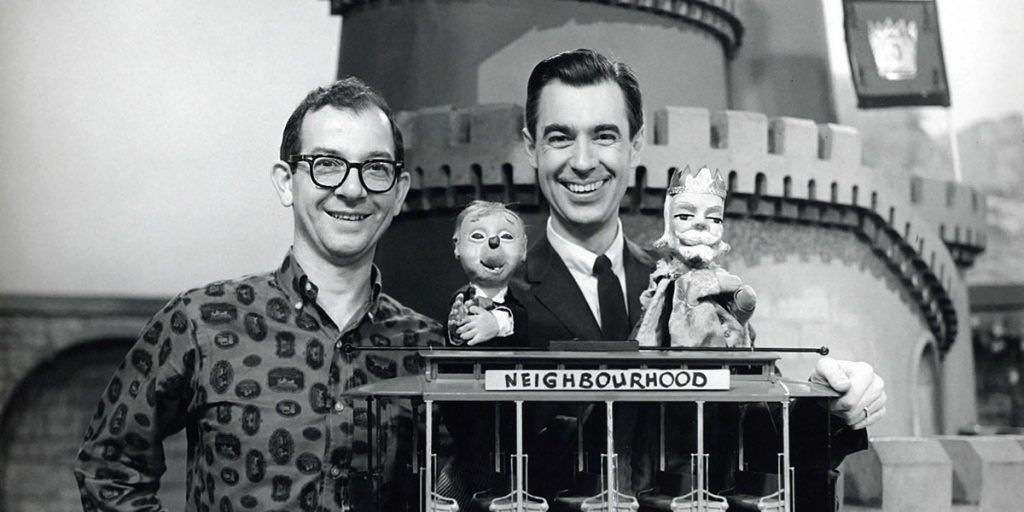
The power and enduring legacy of a children’s television show was on full display Saturday night at a gala screening at the Toronto International Film Festival.
“Mr. Dressup: The Magic of Make-Believe,” is the heartfelt new film from director Robert McCallum. He was embraced by a packed house Saturday at the TIFF Bell Lightbox Theatre. McCallum, who could convincingly dress up as a bearded biker dude, took a bow after the screening. Also on stage were co-producers Mark Bishop and Aeschylus Poulos.
Ernie Coombs, revered across Canada as Mr. Dressup, suffered a stroke and passed away at 73 in 2011. He was represented at the event by his two children, Chris Coombs and Catherine LeFort. Puppeteer Nina Keogh, who also worked on The Friendly Giant and joined Dressup in later years, also took the stage.

Like other stars this year at strike-affected festival, Mr. Dressup’s puppet pals Casey and Finnegan did not walk the red carpet. They were well represented on screen, however, by Judith Lawrence. The Australian-born puppeteer added an essential burst of playfulness and sass to Mr. Dressup’s daytime shenanigans on CBC. Her efforts were a big reason why the series enjoyed a 30 year run.
Many Canadians will be unaware that Coombs was an American who was originally from Maine. (As the documentary shows, he became a Canadian citizen later in life.) He came to Toronto with Fred Rogers in the early ’60s at the invitation of the CBC. Canada’s public broadcaster had a children’s television wing at the time, an almost unheard of indulgence in North American television. Fred Rainsberry was the savvy CBC executive who invited Rogers, whose Pittsburgh-based children’s show had just ended, and his puppeteer/assistant, Coombs, north to spread their whimsy and good cheer in Canada.

For the next two years, the black and white series MisterRogers ran on CBC. Rainsberry, as his daughter explained from her balcony perch at Saturday’s post-screening session, was thus responsible for bringing three titans of children’s television to Canada: Rogers, Coombs and, even earlier, Friendly Giant Bob Homme.
advertisement
When Rogers was lured back to Pittsburgh in 1964, he urged CBC to carry on with Coombs, whose new series launched under the title, Butternut Square (the moniker I remember as a youngster) before seamlessly morphing into Mr. Dressup in 1967. It ran until 1996.
Rainsbury’s savvy recruitments are recorded in “The Magic of Make-Believe,” which also includes heartfelt testimonials from many Canadians charmed and later influenced by Coombs. Michael J. Fox, Eric McCormack, Bif Naked, Paul Sun-Hyung Lee, Andrew Phung, CBC head Catherine Tait, Fred Penner, the four current members of the Barenaked Ladies (three of whom were at the screening), Graham Greene, Kids in the Hall players Bruce McCulloch and Scott Thompson, Jonathan Torrens, Peter Mansbridge and Yannick Bisson all share memories.
McCormack, as he told me late last year on an episode of brioux.tv: the podcast, was greatly inspired by this man on TV who could pull a hat and a costume out of his Tickle Trunk and transform himself into a fireman or a spider. The future Will & Grace Emmy-winner thought doing that might be fun as a career. He and his wife also named their son Finnigan!
It does seem a bit cute that Mr. Dressup should be saluted by somebody named Bif Naked, but filmmaker McCallum makes the point that Coombs’ kind act appealed to all. As McCulloch mentions, you never really knew if Casey was a boy or a girl, and that genderless quality led boys and girls into each daily adventure. It also seems well ahead of its time today.

Speaking for my generation of TV critics is former Toronto Star scribe Rob Salem, who cements his reputation as the Mr. Dressup of commentary by appearing a a florescent green and black Batman villain hoodie covered in Riddler-style question marks. The bold look pulls you momentarily out of the documentary, but then, as you think about it (especially after Rob says some very apt things), seems perfect.
Also providing commentary are a couple of veteran Canadian television luminaries who make very impactful points. Trina McQueen and Peter Moss speak to Coombs’ legacy like no other TV insiders could.
Among the points they make is that Coombs operated outside the general constraints of ad-supported, profit-driven television. Coombs was never trying to sell you something, other than anyone can do anything with a little imagination and perhaps scissors, tape and glue. There was no bottom line, and therefore no ceiling when it came to a child’s creative reach.
The other grand and powerful message of “The Magic of Make-Believe” is that a show that is all about kindness and generosity of spirit and playfulness and fun can have a lot to do with the fabric and reputation of a nation. That we are, or were, a people who say, “Sorry,” when somebody steps on our toe, perhaps is because a lot of us were given a metaphorical hug by fellows named Coombs and Homme Rogers and puppeteers such as Lawrence — all of whom came from other lands. Maybe gentle influences aren’t such a bad thing.
Surviving 30 years on TV for any show is remarkable. For a children’s’ series, well, there were also long runs for Mr. Rogers’ Neighbourhood, Captain Kangaroo, The Friendly Giant and, to this day, Sesame Street. That Dressup spanned, in political terms, from Pearson to Chretien, wasn’t always easy, especially after puppeteer Lawrence retired in 1989, taking Casey and Finnigan with her. Despite that key characters loss, CBC budget cuts (cue a clip of ex-PM Brian Mulroney) and the impact of slicker competition such as Sesame Street, the series rarely dipped below the half million viewers a day mark throughout its long run.
I don’t want to spoil the many emotional moments in “The Magic of Make-Believe.” McCallum goes for them, chronologically, without hesitation. This is a valentine to Coombs’ family, but that family includes everyone who worked on the show, or watched.

The filmmakers were aided by the fact that Mr. Dressup aired at CBC and thus four thousand episodes exist in the CBC archives, where they are carefully curated and available for documentary salutes such as this. That is a one very full tickle trunk if you are making a documentary about a field where entire runs of children’s TV shows were bulk erased or junked.
One of the many poignant clips is of the very last episode of the series, which aired in 1996. It has echoes of the shut down of WJM-TV in the newsroom of The Mary Tyler Moore Show. As the lights dim in Mr. Dressup’s Toronto studio, the camera pans over to Donald Himes, who wrote the series’ sprightly theme, which was performed live in the studio each episode. (The same was true of the recorder and harp duet performed live every time on episodes of The Friendly Giant.) Himes, who died in 2011 at 80, plays it out with a grand, extended flourish.
“Mr. Dressup: The Magic of Make-Believe” plays Sunday in Toronto at the Scotiabank cinema. It will make its television premiere next month on CBC and will also start streaming Oct. 17 on Prime Video, a prime backer of this wonderful film.







